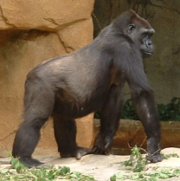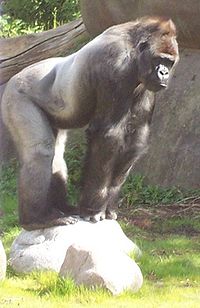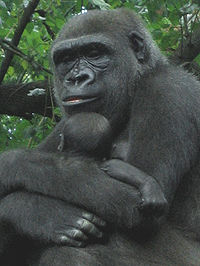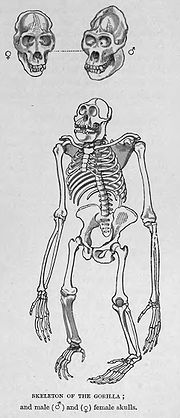
Gorilla
Did you know...
This selection is made for schools by a children's charity read more. See http://www.soschildren.org/sponsor-a-child to find out about child sponsorship.
| Gorilla | |
|---|---|
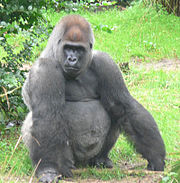 |
|
| Western Gorilla (Gorilla gorilla) |
|
| Scientific classification | |
| Kingdom: | Animalia |
| Phylum: | Chordata |
| Class: | Mammalia |
| Order: | Primates |
| Family: | Hominidae |
| Subfamily: | Homininae |
| Tribe: | Gorillini |
| Genus: | Gorilla I. Geoffroy, 1852 |
| Type species | |
| Troglodytes gorilla Savage, 1847 |
|
| Species | |
|
Gorilla gorilla |
|
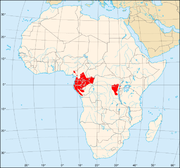 |
|
| distribution of Gorilla | |
Gorillas, the largest of the living primates, are ground-dwelling herbivores that inhabit the forests of Africa. Gorillas are divided into two species and (still under debate as of 2008) either four or five subspecies. The DNA of gorillas is 97%–98% identical to that of a human, and they are the next closest living relatives to humans after the two chimpanzee species.
Gorillas live in tropical or subtropical forests. Although their range covers a small percentage of Africa, gorillas cover a wide range of elevations. The Mountain Gorilla inhabits the Albertine Rift montane cloud forests of the Virunga Volcanoes, ranging in altitude from 2225 to 4267 m (7300-14000 ft). Lowland Gorillas live in dense forests and lowland swamps and marshes as low as sea level.
Etymology
The American physician and missionary Thomas Staughton Savage first described the Western Gorilla (he called it Troglodytes gorilla) in 1847 from specimens obtained in Liberia. The name was derived from the Greek word Gorillai (a "tribe of hairy women") described by Hanno the Navigator, a Carthaginian navigator and possible visitor (circa 480 BC) to the area that later became Sierra Leone.
Classification
Until recently there were considered to be three gorilla species: the Western Lowland Gorilla, the Eastern Lowland Gorilla and the Mountain Gorilla. There is now agreement that there are two species with two subspecies each. More recently it has been claimed that a third subspecies exists in one of the species.
Primatologists continue to explore the relationships between various gorilla populations. The species and subspecies listed here are the ones upon which most scientists agree.
- Genus Gorilla
- Western Gorilla (Gorilla gorilla)
- Western Lowland Gorilla (Gorilla gorilla gorilla)
- Cross River Gorilla (Gorilla gorilla diehli)
- Eastern Gorilla (Gorilla beringei)
- Mountain Gorilla (Gorilla beringei beringei)
- Eastern Lowland Gorilla (Gorilla beringei graueri)
- Western Gorilla (Gorilla gorilla)
The proposed third subspecies of Gorilla beringei, which has not yet received a trinomen, is the Bwindi population of the Mountain Gorilla, sometimes called the Bwindi Gorilla.
Physical characteristics
Gorillas move around by knuckle-walking. Adult males range in height from 165-175 cm (5 ft 5 in – 5 ft 9 in), and in weight from 140–204.5 kg (310–450 lb). Adult females are often half the size of a silverback, averaging about 140 cm (4 ft 7 in) tall and 100 kg (220 lb). Occasionally, a silverback of over 183 cm (6 ft) and 225 kg (500 lb) has been recorded in the wild. However, obese gorillas in captivity have reached a weight of 270 kg (600 lb). Gorillas have a facial structure which is described as mandibular prognathism, that is, their mandible protrudes farther out than the maxilla.
The Eastern Gorilla is more darkly colored than the Western Gorilla, with the Mountain Gorilla being the darkest of all. The Mountain Gorilla also has the thickest hair. The Western Lowland Gorilla can be brown or grayish with a reddish forehead. In addition, gorillas that live in lowland forests are more slender and agile than the more bulky Mountain Gorilla.
Almost all gorillas share the same blood type (B) and, like humans, have individual finger prints.
Behaviour
Group life
A silverback is an adult male gorilla, typically more than 12 years of age and named for the distinctive patch of silver hair on his back. A silverback gorilla has large canine teeth that come with maturity. Black backs are sexually mature males of up to 11 years of age.
Silverbacks are the strong, dominant troop leaders. Each typically leads a troop ( group size ranges from 5 to 30) and is in the centre of the troop's attention, making all the decisions, mediating conflicts, determining the movements of the group, leading the others to feeding sites and taking responsibility for the safety and well-being of the troop. Younger males called blackbacks may serve as backup protection.
Males will slowly begin to leave their original troop when they are about 11 years old, traveling alone or with a group of other males for 2–5 years before being able to attract females to form a new group and start breeding. While infant gorillas normally stay with their mother for 3–4 years, silverbacks will care for weaned young orphans, though never to the extent of carrying the little gorillas.
If challenged by a younger or even by an outsider male, a silverback will scream, beat his chest, break branches, bare his teeth, then charge forward. Sometimes a younger male in the group can take over leadership from an old male. If the leader is killed by disease, accident, fighting or poachers, the group will split up, as the animals disperse to look for a new protective male. Very occasionally, a group might be taken over in its entirety by another male. There is a strong risk that the new male may kill the infants of the dead silverback.
Food and foraging
Gorillas are herbivores, eating fruits, leaves, and shoots. Further they are classified as foliovores. Much like other animals that feed on plants and shoots, they sometimes ingest small insects also. Gorilla spend most of the day eating. Their large sagittal crest and long canines allow them to crush hard plants like bamboo. Lowland gorillas feed mainly on fruit while Mountain gorillas feed mostly on herbs, stems and roots.
Reproduction and lifespan
Gestation is 8½ months. There are typically 3 to 4 years between births. Infants stay with their mothers for 3–4 years. Females mature at 10–12 years (earlier in captivity); males at 11–13 years. Lifespan is between 30–50 years, although there have been exceptions. For example the Dallas Zoo's Jenny is still alive at age 55. Recently, gorillas have been observed engaging in face-to-face sex, a trait that was once considered unique to humans and the Bonobo.
Intelligence
Gorillas are closely related to humans and are considered highly intelligent. A few individuals in captivity, such as Koko, have been taught a subset of sign language (see animal language for a discussion).
Tool use
The following observations were made by a team led by Thomas Breuer of the Wildlife Conservation Society in September 2005. Gorillas are now known to use tools in the wild. A female gorilla in the Nouabalé-Ndoki National Park in the Republic of Congo was recorded using a stick as if to gauge the depth of water whilst crossing a swamp. A second female was seen using a tree stump as a bridge and also as a support whilst fishing in the swamp. This means that all of the great apes are now known to use tools.
In September 2005, a two and a half year old gorilla in the Republic of Congo was discovered using rocks to smash open palm nuts inside a game sanctuary. While this was the first such observation for a gorilla, over forty years previously chimpanzees had been seen using tools in the wild, famously 'fishing' for termites. It is a common tale among native peoples that gorillas have used rocks and sticks to thwart predators, even rebuking large mammals. Great apes are endowed with a semi-precision grip, and certainly have been able to use both simple tools and even weapons, by improvising a club from a convenient fallen branch.
Studies
The word "gorilla" comes from the history of Hanno the Navigator, a Carthaginian explorer on an expedition on the west African coast. They encountered "a savage people, the greater part of whom were women, whose bodies were hairy, and whom our interpreters called Gorillae" . The word was then later used as the species name, though it is unknown whether what these ancient Carthaginians encountered were truly gorillas, another species of ape or monkeys, or humans.
American physician and missionary Thomas Staughton Savage obtained the first specimens (the skull and other bones) during his time in Liberia in Africa. The first scientific writings about describing gorillas date back to the publication of an article in 1847 in Proceedings of the Boston Society of Natural History, where Troglodytes gorilla is described, now known as the Western Gorilla. Other species of gorilla are described in the next couple of years.
Explorer Paul du Chaillu was the first westerner to see a live gorilla during his travel through western equatorial Africa from 1856 to 1859. He brought dead specimens to England in 1861 .
The first systematic study was not conducted until the 1920s, when Carl Akeley of the American Museum of Natural History traveled to Africa to hunt for an animal to be shot and stuffed. On his first trip he was accompanied by his friends Mary Bradley, a famous mystery writer, and her husband. After their trip, Mary Bradley wrote On the Gorilla Trail. She later became an advocate for the conservation of gorillas and wrote several more books (mainly for children). In the late 1920s and early 1930s, Robert Yerkes and his wife Ava helped further the study of gorillas when they sent Harold Bigham to Africa. Yerkes also wrote a book in 1929 about the great apes.
After WWII, George Schaller was one of the first researchers to go into the field and study primates. In 1959, he conducted a systematic study of the Mountain Gorilla in the wild and published his work. Years later, at the behest of Louis Leakey and the National Geographic, Dian Fossey conducted a much longer and more comprehensive study of the Mountain Gorilla. It was not until she published her work that many misconceptions and myths about gorillas were finally disproved, including the myth that gorillas are violent.
Endangerment
Both species of gorilla are endangered, and have been subject to intense poaching for a long time. Threats to gorilla survival include habitat destruction and the bushmeat trade. In 2004 a population of several hundred gorillas in the Odzala National Park, Republic of Congo was essentially wiped out by the Ebola virus. A 2006 study published in Science concluded that more than 5,000 gorillas may have died in recent outbreaks of the Ebola virus in central Africa. The researchers indicated that in conjunction with commercial hunting of these apes creates "a recipe for rapid ecological extinction". Conservation efforts include the Great Ape Survival Project, a partnership between the United Nations Environment Programme and the United Nations Educational, Scientific and Cultural Organization, and also an international treaty, the Agreement on the Conservation of Gorillas and Their Habitats, concluded under UNEP-administered Convention on Migratory Species. The Gorilla Agreement is the first legally-binding instrument exclusively targeting Gorilla conservation and comes into effect on 1 June 2008.

